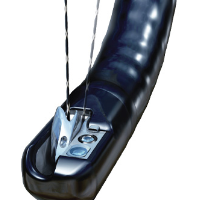European Hospitals Got Medical Alerts on Deadly Scopes 2 Years Before U.S.
 TJF-Q180V duodenoscope (photo: Olympus)
TJF-Q180V duodenoscope (photo: Olympus)
Days after Ronald Reagan UCLA Medical Center began warning 179 patients in February that they may have caught the deadly CRE bacteria from a medical scope, the instrument’s maker, Olympus, sent out its first nationwide alert about sterilization issues it was aware of.
It was not, however, the first such alert the Japanese manufacturer had issued about the hard-to-clean scopes linked to seven sick patients at UCLA, including two dead ones, according to the Los Angeles Times. There have been reports of outbreaks in a handful of other states since 2012, including Illinois, Pennsylvania and Washington State.
Olympus sent out warning letters in January 2013 to hospitals across Europe, asking them to sign and return a form acknowledging they were spreading the word about difficulty in cleaning the specific part of the scope that has turned out to be troublesome. In August 2014, the company sent out another round of letters with specific recommendations for cleaning the instrument after it continued to get complaints.
National regulatory agencies posted notices about it on their websites.
But, somehow, the word did not make it across the giant watery expanse that separates the two continents in any meaningful way, although it was not totally unknown. The Food and Drug Administration (FDA) told the Times it learned of the European letters last summer, but did not alert hospitals because the agency and the manufacturers were working on cleaning procedures that might actually work.
Around half a million people undergo endoscopic retrograde cholangiopancreatography (ERCP) annually, and Olympus makes about 70% of the scopes used to test and treat a range of ailments, including gallstones and cancer.
The seven patients at UCLA and four others at Cedars Sinai Medical Center in Los Angeles contracted carbapenem-resistant Enterobacteriaceae, a bacteria that does not respond well to antibiotics.
And the scopes themselves, apparently, do not respond well to cleaning. Olympus upgraded its initial instructions for how to sterilize the instrument, but they might not be good enough.
A report last month in the Infection Control & Hospital Epidemiology, the journal of the Society for Healthcare Epidemiology of America, examined how new sterlization procedures were working in a Seattle hospital where 32 patients were infected with E.coli between November 2012 and August 2013. The answer was: not well.
“We suspect endoscope-associated transmission of bacteria is more common than recognized and not adequately prevented by current reprocessing guidelines,” lead author Kristen Wendorf, said of the study. “Although the endoscopes had been reprocessed according to industry standards, we identified contaminated endoscopes that might have facilitated the transmission of the multidrug-resistant organism.”
So far, no one is claiming to have a foolproof sterilization system, although Olympus sent hospitals a new brush last month for cleaning the devices. Many hospitals are now using an elaborate cleaning process that involves taking the scopes out of action for 48 hours.
But Virginia Mason Medical Center began doing that and applying a “meticulous manual cleaning” after 32 people became infected and 11 died, according to BloombergBusiness. The medical center reported that even with its intense efforts, 3% of the scopes remained infected.
–Ken Broder
To Learn More:
Scope Maker Warned Europe About Contamination 2 Years Before L.A. Infections (by Melody Petersen and Chad Terhune, Los Angeles Times)
Can Anything Kill the Deadly Bacteria on Endoscopes? (by John Tozzi, BloombergBusiness)
Reports to Feds on Deadly Bacteria Outbreaks Arrived Late (by Peter Eisler, USA Today)
FDA Warns About Medical Scopes After “Superbug” Bacteria Hits UCLA Hospital (by Lindsey Bever and Brady Dennis, Washington Post)
UCLA Hospital Warns 179 Ex-Patients of Superbug Linked to Two Deaths (by Ken Broder, AllGov California)
- Top Stories
- Controversies
- Where is the Money Going?
- California and the Nation
- Appointments and Resignations
- Unusual News
- Latest News
- California Forbids U.S. Immigration Agents from Pretending to be Police
- California Lawmakers Urged to Strip “Self-Dealing” Tax Board of Its Duties
- Big Oil’s Grip on California
- Santa Cruz Police See Homeland Security Betrayal in Use of Gang Roundup as Cover for Immigration Raid
- Oil Companies Face Deadline to Stop Polluting California Groundwater





